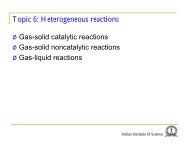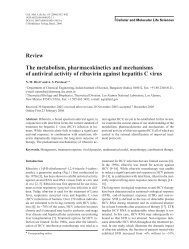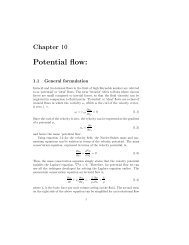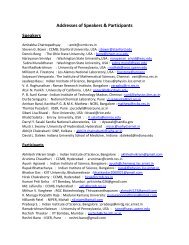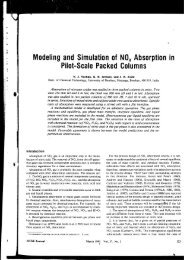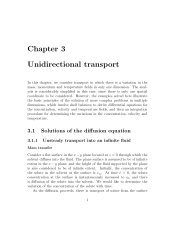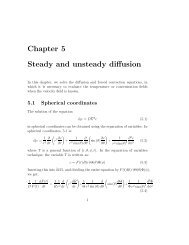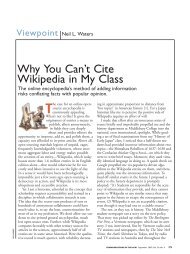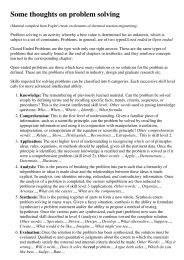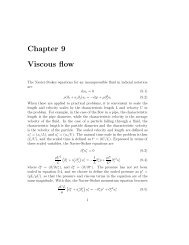Chapter 11 Boundary layer theory
Chapter 11 Boundary layer theory
Chapter 11 Boundary layer theory
You also want an ePaper? Increase the reach of your titles
YUMPU automatically turns print PDFs into web optimized ePapers that Google loves.
4 CHAPTER <strong>11</strong>. BOUNDARY LAYER THEORY<br />
l = Re −1/2 L in equation <strong>11</strong>.14, to get the scaled momentum equation in<br />
the streamwise direction,<br />
u ∗ ∂u ∗ x<br />
x<br />
∂x ∗ + u∗ y<br />
∂u ∗ y<br />
∂y ∗ = −∂p∗ ∂x ∗ + ∂2 u ∗ x<br />
∂y ∗2 (<strong>11</strong>.15)<br />
Next, we analyse the momentum equation in the cross-stream direction,<br />
<strong>11</strong>.<strong>11</strong>. This equation is expressed in terms of the scaled spatial co-ordinates,<br />
velocities and pressure, to obtain,<br />
ρU∞ 2 l (<br />
u ∗ u ∗ y<br />
L 2 x<br />
x + ∂u ∗ )<br />
⎛<br />
∗ u∗ y<br />
y = − ρU2 ∞ ∂p ∗<br />
∂y ∗ l ∂y + µU ∞ ⎝ ∂2 u ∗ ( ) ⎞ 2<br />
y l ∗ lL ∂y + ∂ 2 u ∗ y ⎠<br />
∗2 L ∂x ∗2 (<strong>11</strong>.16)<br />
By examining all terms in the above equation, it is easy to see that the<br />
largest terms is the pressure gradient in the cross-stream direction. We divide<br />
throughout by the pre-factor of this term, and substitute (l/L) = Re −1/2 , to<br />
obtain,<br />
Re<br />
(u −1 ∗ u ∗ y<br />
x<br />
x + ∂u ∗ )<br />
∗ u∗ y<br />
y = − ∂p (<br />
∗ ∂ 2<br />
∂y ∗ ∂y + u ∗<br />
∗ Re−1 y<br />
∂y + u ∗ )<br />
∗2 Re−1∂2 y<br />
(<strong>11</strong>.17)<br />
∂x ∗2<br />
In the limit Re ≫ 1, the above momentum conservation equation reduces to,<br />
∂p ∗<br />
∂y ∗ = 0 (<strong>11</strong>.18)<br />
Thus, the pressure gradient in the cross-stream direction is zero in the leading<br />
approximation, and the pressure at any streamwise location in the boundary<br />
<strong>layer</strong> is the same as that in the free-stream at that same stream-wise location.<br />
This is a salient feature of the flow in a boundary <strong>layer</strong>s. Thus, the<br />
above scaling analysis has provided us with the simplified ‘boundary <strong>layer</strong><br />
equations’ <strong>11</strong>.12, <strong>11</strong>.15 and <strong>11</strong>.18, in which we neglect all terms that are o(1)<br />
in an expansion in the parameter Re −1/2 . Expressed in dimensional form,<br />
these mass conservation equation is <strong>11</strong>.9, while the approximate momentum<br />
conservation equations are,<br />
(<br />
)<br />
∂u x<br />
ρ u x<br />
∂x + u ∂u x<br />
y = − ∂p<br />
∂y ∂x + u x<br />
µ∂2 (<strong>11</strong>.19)<br />
∂y 2<br />
∂p<br />
∂y = 0 (<strong>11</strong>.20)



